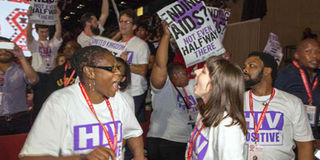Sugar daddies a threat to war on Aids in SA

Treatment Action Campaign (TAC) activists protest during the official opening of the 21st International AIDS conference at the International Convention Centre in Durban on July 18, 2016. In South Africa, seven million people live with HIV — and older men are thought to be largely to blame for the shockingly high rate of infections among teenage girls and young women. PHOTO | AFP
What you need to know:
- The danger of the “blessers” has been in the spotlight at the International Aids Conference in Durban this week.
- Age-gap relationships are the engine driving the HIV epidemic in sub-Saharan Africa, explained Prof Salim Abdool Karim, director of the Centre for the AIDS Programme of Research in South Africa.
DURBAN, Thursday
Lebogang Motsumi, 27, still remembers the moment when she learnt she had contracted HIV from a man a decade her senior.
“It was August 15, 2009, at 1pm,” she said, recalling the instant when her life changed traumatically.
“I was so ignorant,” she said. “I thought HIV had a face” — thin, poor and dying — “and I wasn’t that face.”
The man who infected her with the Aids virus was a “sugar daddy” or, in local parlance, a “blesser” — an older man who “blesses” a younger, often poorer girl with money and gifts and expects sex in return.
The danger of the “blessers” has been in the spotlight at the International Aids Conference in Durban this week.
In South Africa, seven million people live with HIV — and older men are thought to be largely to blame for the shockingly high rate of infections among teenage girls and young women.
“To the ‘blessers’, there is only one level I want: the zero level, zero tolerance for men who put adolescent girls at risk for HIV,” Unaids chief Michel Sidibe declared on Monday at the conference’s opening session.
Every week, an estimated 2,000 South African women between the ages of 15 and 24 contract HIV.
Girls between the ages of 15 and 19 are up to eight times more likely to be HIV-positive than boys of the same age.
Age-gap relationships are the engine driving the HIV epidemic in sub-Saharan Africa, explained Prof Salim Abdool Karim, director of the Centre for the AIDS Programme of Research in South Africa.
The programme examined the genetic sequences of HIV in a community in the KwaZulu-Natal Province — the hotbed of South Africa’s epidemic — to track how it was being spread.
The results revealed a cycle of infection.
“Over three out of every five young women — teenagers and women in their very early 20s — acquired HIV from a man around his thirties, about eight to 10 years older,” Prof Abdool Karim told AFP.
The skewed power dynamics in these relationships make it difficult for the young women to demand safe sex, increasing their chances of contracting the virus.
“You don’t even want to talk condoms, or the guy will think you’re being promiscuous,” said Motsumi, who was 17 when she started going out with her older partner.
“You know you should, but he’s in control of the sex: when you have it, how you have it.”
It was a problem made worse by parents and nurses more intent on delivering moral lectures than helping her make informed decisions, she said.
“It’s transactional, not love,” said Motsumi who, after a string of such relationships, is sharing her experiences at the Durban conference.





